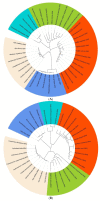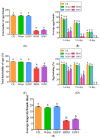Chromatin-Remodelling ATPases ISWI and BRM Are Essential for Reproduction in the Destructive Pest Tuta absoluta
- PMID: 35328688
- PMCID: PMC8951242
- DOI: 10.3390/ijms23063267
Chromatin-Remodelling ATPases ISWI and BRM Are Essential for Reproduction in the Destructive Pest Tuta absoluta
Abstract
The tomato leaf miner (Tuta absoluta) is one of the top 20 plant pests worldwide. We cloned and identified the chromatin-remodelling ATPase genes ISWI and BRM by RACE and bioinformatic analysis, respectively; used RT-qPCR to examine their expression patterns during different life cycle stages; and elucidated their roles in insect reproduction using double-stranded RNA injections. The full-length cDNA of TaISWI was 3428 bp and it encoded a 1025-aa polypeptide. The partial-length cDNA of TaBRM was 3457 bp and it encoded a 1030-aa polypeptide. TaISWI and TaBRM were upregulated at the egg stage. Injection of TaISWI or TaBRM dsRNA at the late pupa stage significantly inhibited adult ovary development and reduced fecundity, hatchability, and longevity in the adult females. To the best of our knowledge, the present study was the first to perform molecular characterisations of two chromatin-remodelling ATPase genes and clarify their roles in T. absoluta fecundity. Chromatin-remodelling ATPases are potential RNAi targets for the control of T. absoluta and other insect pests. The present study was also the first to demonstrate the feasibility of reproductive inhibitory RNAi as a putative approach for the suppression of T. absoluta and other Lepidopteran insect populations.
Keywords: RNA interference; Tuta absoluta; bromo; fecundity; imitation SWItch.
Conflict of interest statement
The authors declare no conflict of interest.
Figures





Similar articles
-
Life-table analyses for the tomato leaf miner, Tuta absoluta (Meyrick) (Lepidoptera: Gelechiidae): effects of plant genotype.Pest Manag Sci. 2023 Jun;79(6):2117-2125. doi: 10.1002/ps.7392. Epub 2023 Feb 13. Pest Manag Sci. 2023. PMID: 36710382
-
De novo transcriptome assembly and analysis to identify potential gene targets for RNAi-mediated control of the tomato leafminer (Tuta absoluta).BMC Genomics. 2015 Aug 26;16(1):635. doi: 10.1186/s12864-015-1841-5. BMC Genomics. 2015. PMID: 26306628 Free PMC article.
-
RNAi targeting Nav and CPR via leaf delivery reduces adult emergence and increases the susceptibility to λ-cyholthin in Tuta absoluta (Meyrick).Pestic Biochem Physiol. 2024 Sep;204:106089. doi: 10.1016/j.pestbp.2024.106089. Epub 2024 Aug 20. Pestic Biochem Physiol. 2024. PMID: 39277402
-
Ex vivo delivery of dsRNA targeting ryanodine receptors for control of Tuta absoluta.Pest Manag Sci. 2024 Dec;80(12):6400-6408. doi: 10.1002/ps.8368. Epub 2024 Aug 16. Pest Manag Sci. 2024. PMID: 39148493
-
Current Strategies and Future Outlook for Managing the Neotropical Tomato Pest Tuta absoluta (Meyrick) in the Mediterranean Basin.Neotrop Entomol. 2019 Feb;48(1):1-17. doi: 10.1007/s13744-018-0636-1. Epub 2018 Oct 3. Neotrop Entomol. 2019. PMID: 30284151 Review.
References
-
- Garcia M.F., Espul J.C. Bioecology of the tomato moth (Scrobipalpula absoluta) in Mendoza, Argentine Republic. Rev. Investig. Agrop. 1982;17:135–146.
-
- Desneux N., Wajnberg E., Wyckhuys K.A.G., Burgio G., Arpaia S., Narváez-Vasquez C.A., González-Cabrera J., Ruescas D.C., Tabone E., Frandon J., et al. Biological invasion of European tomato crops by Tuta absoluta: Ecology, geographic expansion and prospects for biological control. J. Pest Sci. 2010;83:197–215. doi: 10.1007/s10340-010-0321-6. - DOI
-
- Desneux N., Luna M.G., Guillemaud T., Urbaneja A. The invasive South American tomato pinworm, Tuta absoluta, continues to spread in Afro-Eurasia and beyond: The new threat to tomato world production. J. Pest Sci. 2011;84:403–408. doi: 10.1007/s10340-011-0398-6. - DOI
MeSH terms
Substances
Grants and funding
LinkOut - more resources
Full Text Sources

